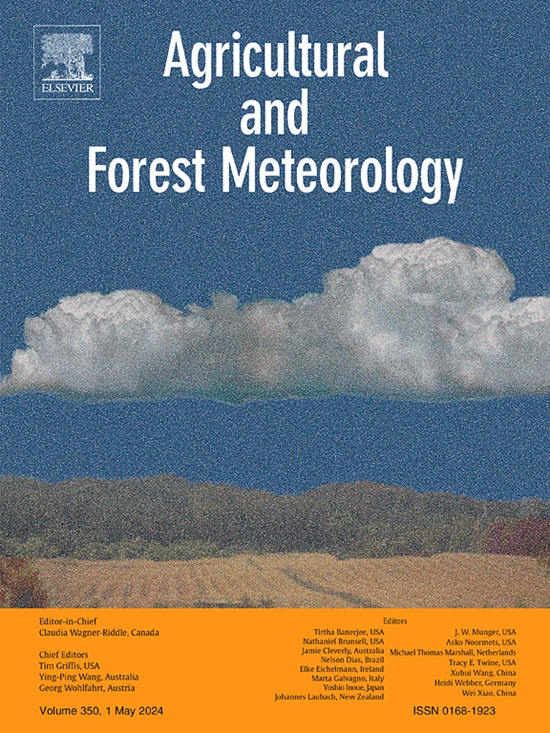Vapor pressure deficit dominates dryness stress on forest biomass carbon in China under global warming
IF 5.6
1区 农林科学
Q1 AGRONOMY
引用次数: 0
Abstract
Soil moisture (SM) and vapor pressure deficit (VPD) are key factors affecting forest carbon stock. However, their effects on forest biomass carbon under hotter and drier climate trends are unclear. These knowledge gaps limit forest management practices and the implementation of climate change mitigation programs. In this study, satellite observations and meteorological data were combined to analyze the asymmetric response of forest biomass carbon to wet and dry changes in China from 2002 to 2020 and identify the relative contributions and influence pathways of SM and VPD on forest biomass carbon under global warming. The results showed that drought did not lead to a decrease in forest biomass carbon but slowed its rate of increase. Excluding the interaction effects of SM and VPD with temperature (Tmp), the dominant effects of SM and VPD on forest biomass carbon differed between dry and wet regions, but the effects of VPD on forest biomass carbon were broader and larger. Notably, the interaction of Tmp and VPD not only amplifies the positive effects of warming on humid regions but also amplifies the negative effects of warming on semi-arid regions, and to some extent offsets the positive effects of warming on sub-humid regions. Additionally, in warming environments, VPD exerts the greatest stress on forest biomass carbon in areas where precipitation (Pre) is 400–700 mm yr−1 and potential evapotranspiration (Pet) is 650–900 mm yr−1. Our results reconcile the contradictions regarding the relative importance of SM and VPD on forest carbon storage and the direction of the influence of VPD on forest carbon sequestration, thereby enhancing our understanding of forest ecosystem carbon cycling in response to climate change.
全球变暖背景下,水汽压亏缺对中国森林生物量碳的干旱胁迫起主导作用
土壤水分(SM)和水汽压亏缺(VPD)是影响森林碳储量的关键因素。然而,在更热和更干燥的气候趋势下,它们对森林生物量碳的影响尚不清楚。这些知识差距限制了森林管理实践和减缓气候变化方案的实施。本研究利用卫星观测和气象资料相结合,分析了2002 - 2020年中国森林生物量碳对干湿变化的不对称响应,确定了全球变暖背景下SM和VPD对森林生物量碳的相对贡献和影响途径。结果表明,干旱没有导致森林生物量碳的减少,但减缓了其增加速度。排除SM和VPD与温度(Tmp)的交互作用,SM和VPD对森林生物量碳的主导作用在干湿地区存在差异,但VPD对森林生物量碳的影响范围更广、更大。值得注意的是,Tmp和VPD的相互作用不仅放大了变暖对湿润地区的正效应,也放大了变暖对半干旱区的负效应,并在一定程度上抵消了变暖对半湿润地区的正效应。此外,在变暖环境中,VPD对森林生物量碳的影响最大的地区是降水量(Pre)为400-700 mm yr - 1,潜在蒸散(Pet)为650-900 mm yr - 1。我们的研究结果调和了SM和VPD对森林碳储量的相对重要性以及VPD对森林固碳影响方向的矛盾,从而增强了我们对气候变化下森林生态系统碳循环的认识。
本文章由计算机程序翻译,如有差异,请以英文原文为准。
求助全文
约1分钟内获得全文
求助全文
来源期刊
CiteScore
10.30
自引率
9.70%
发文量
415
审稿时长
69 days
期刊介绍:
Agricultural and Forest Meteorology is an international journal for the publication of original articles and reviews on the inter-relationship between meteorology, agriculture, forestry, and natural ecosystems. Emphasis is on basic and applied scientific research relevant to practical problems in the field of plant and soil sciences, ecology and biogeochemistry as affected by weather as well as climate variability and change. Theoretical models should be tested against experimental data. Articles must appeal to an international audience. Special issues devoted to single topics are also published.
Typical topics include canopy micrometeorology (e.g. canopy radiation transfer, turbulence near the ground, evapotranspiration, energy balance, fluxes of trace gases), micrometeorological instrumentation (e.g., sensors for trace gases, flux measurement instruments, radiation measurement techniques), aerobiology (e.g. the dispersion of pollen, spores, insects and pesticides), biometeorology (e.g. the effect of weather and climate on plant distribution, crop yield, water-use efficiency, and plant phenology), forest-fire/weather interactions, and feedbacks from vegetation to weather and the climate system.

 求助内容:
求助内容: 应助结果提醒方式:
应助结果提醒方式:


